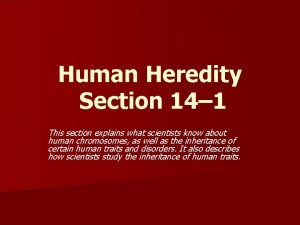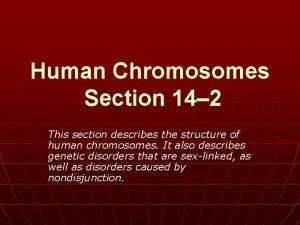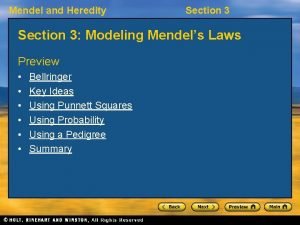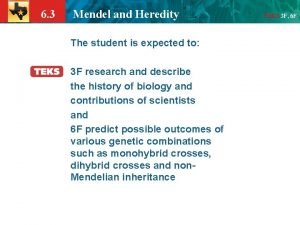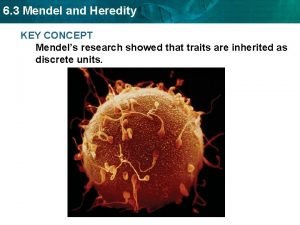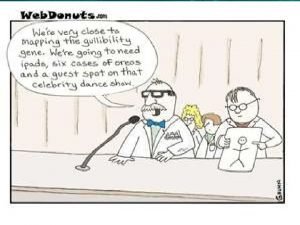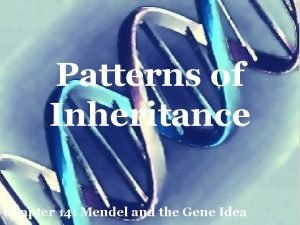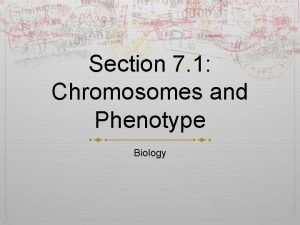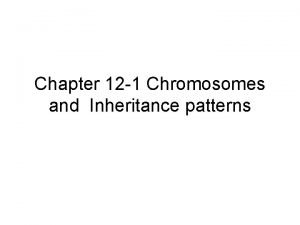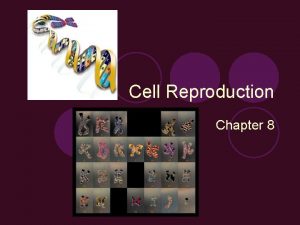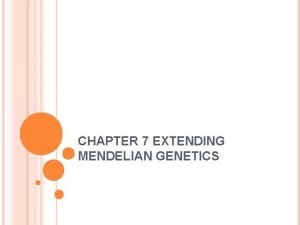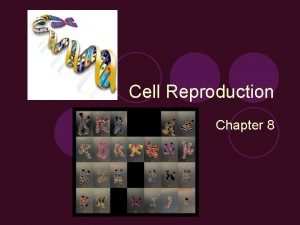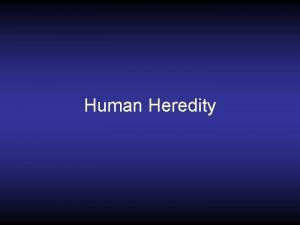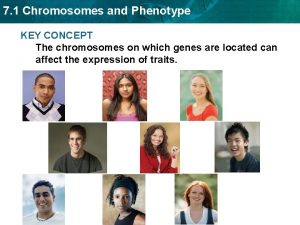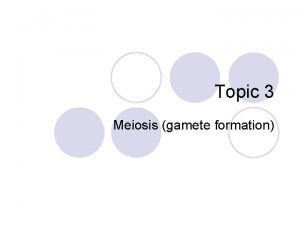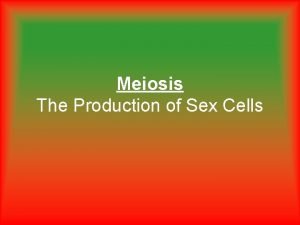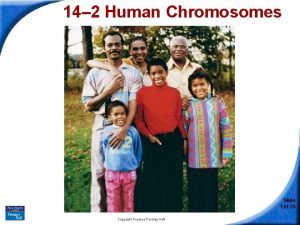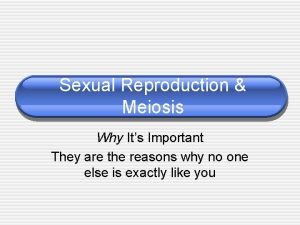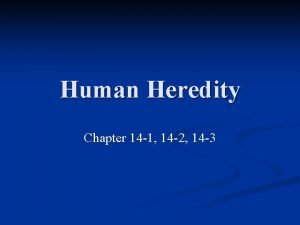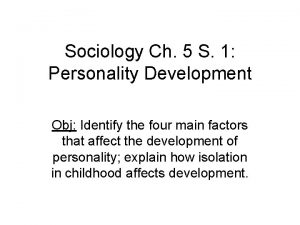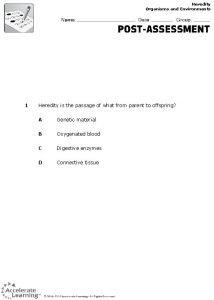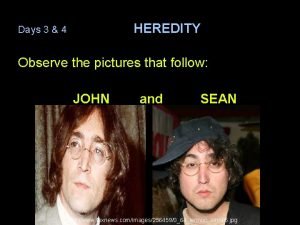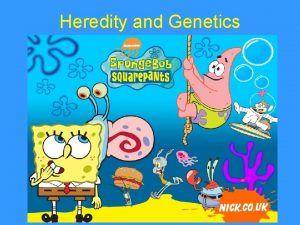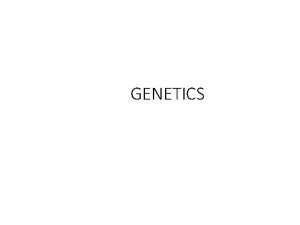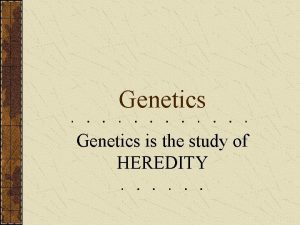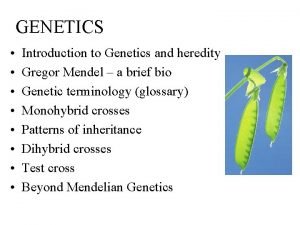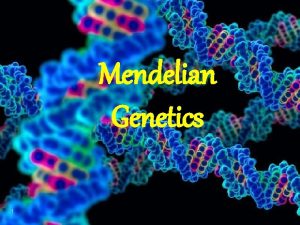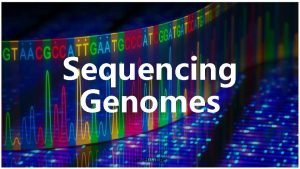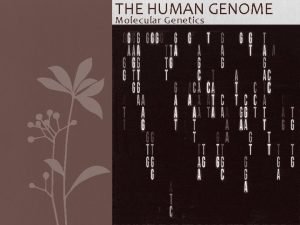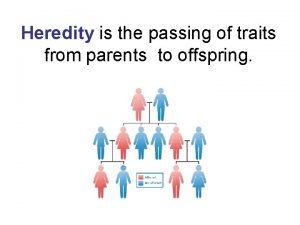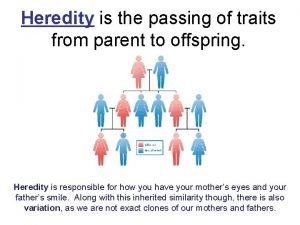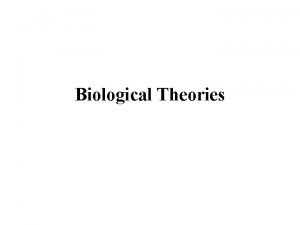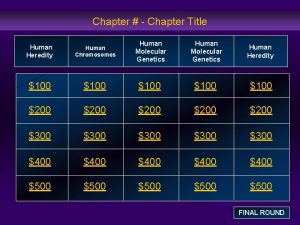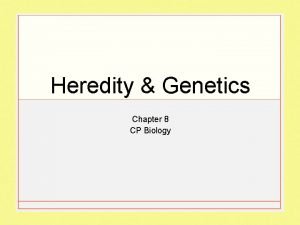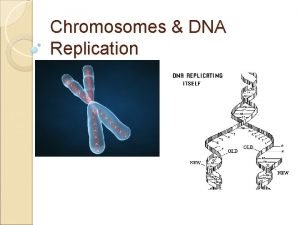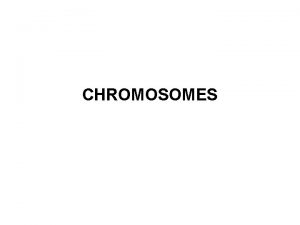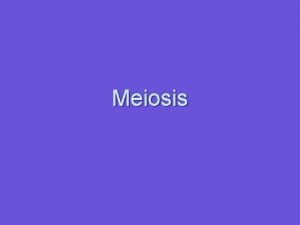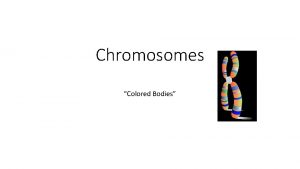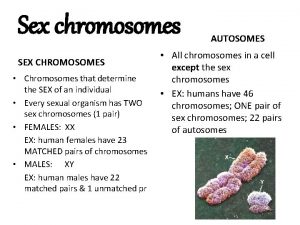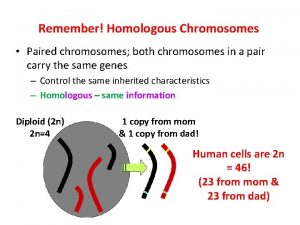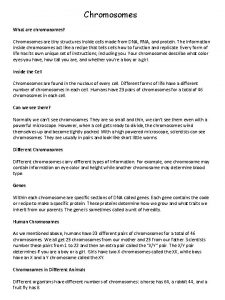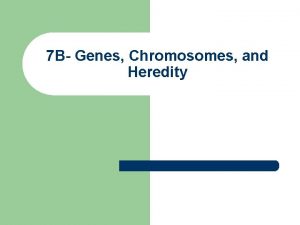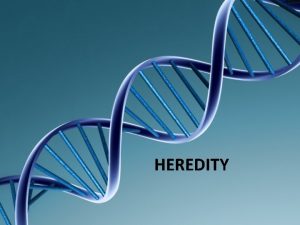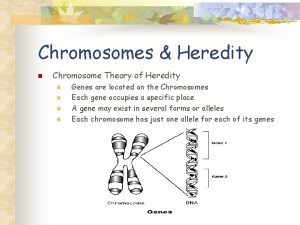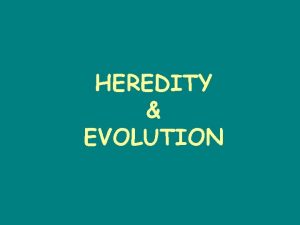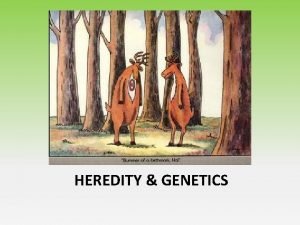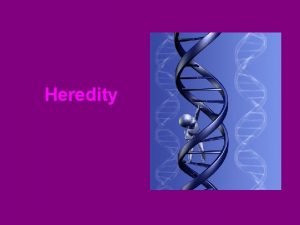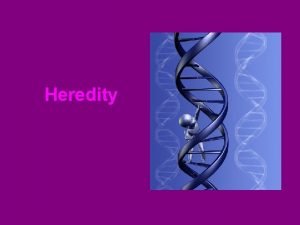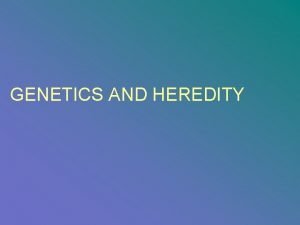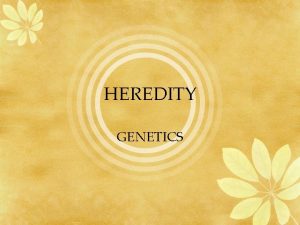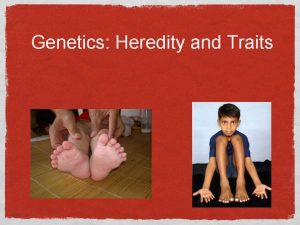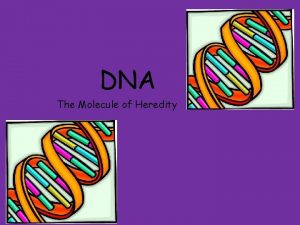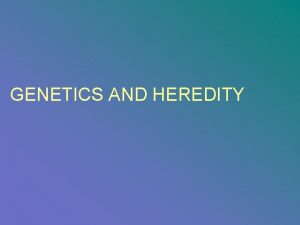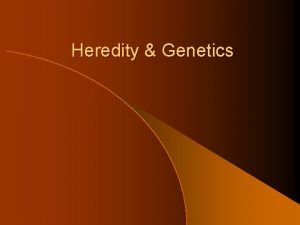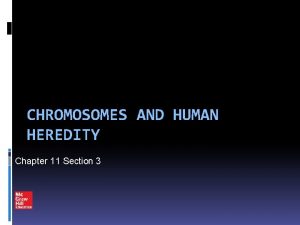Chapter 14 Section 1 Human Heredity Human Chromosomes













































- Slides: 45

Chapter 14 Section 1 Human Heredity

Human Chromosomes � Human chromosomes • 46 total, 23 pairs � 22 pairs of autosomes � 1 pair of sex chromosomes �Male vs. female


Human Chromosomes � Human chromosomes • 46 total, 23 pairs � 22 pairs of autosomes � 1 pair of sex chromosomes �Male vs. female • Karyotype �Picture taken of chromosomes while they are condensed �Used to look for genetic problems

�Tracking traits • Pedigree � Family tree that follows one particular trait

Figure 14 -3 A Pedigree Section 14 -1 A circle represents a female. A horizontal line connecting a male and female represents a marriage. A half-shaded circle or square indicates that a person is a carrier of the trait. A completely shaded circle or square indicates that a person expresses the trait. A square represents a male. A vertical line and a bracket connect the parents to their children. A circle or square that is not shaded indicates that a person neither expresses the trait nor is a carrier of the trait.

�Tracking traits • Pedigree � Family tree that follows one particular trait � Circle=female, square=male � Shading significance

�Human genome • Our complete set of genetic information • Maps out the genes on each chromosome • Established in 2003



Recessive Genetic Disorders � PKU phenylketoneuria • Individuals lack an enzyme needed to breakdown phenylalanine • If have amino acid build up in brain tissue �Mental retardation • All babies in US are tested for defect on chromosome 12


Recessive Genetic Disorders � � PKU phenylketoneuria • Individuals lack an enzyme needed to breakdown phenylalanine • If have amino acid build up in brain tissue �Mental retardation • All babies in US are tested for defect on chromosome 12 • Treatment. Tay Sachs • Common in Jewish families of European descent • Causes nervous system to breakdown �Causes death in first few years of life • No treatment • Can be tested for presence of allele

Recessive Genetic Disorders �Cystic Fibrosis • Common among people of Northern Europe descent �Chromosome 7 • Defect in Cl- protein channels causes mucus to become very thick


Figure 14 -8 The Cause of Cystic Fibrosis Section 14 -1 Chromosome # 7 CFTR gene The most common allele that causes cystic fibrosis is missing 3 DNA bases. As a result, the amino acid phenylalanine is missing from the CFTR protein. Normal CFTR is a chloride ion channel in cell membranes. Abnormal CFTR cannot be transported to the cell membrane. The cells in the person’s airways are unable to transport chloride ions. As a result, the airways become clogged with a thick mucus.

Recessive Genetic Disorders �Cystic Fibrosis • Common among people of Northern Europe descent �Chromosome 7 • Defect in Cl- protein channels causes mucus to become very thick �Lungs and digestive tract effected • Treament-

Recessive Genetic Disorders �Sickle Cell disease • Prevalent among African Americans • Affects hemoglobin chain �Carries oxygen �Causes cell shape to change


Recessive Genetic Disorders �Sickle Cell disease • Prevalent among African Americans • Affects hemoglobin chain �Carries oxygen �Causes cell shape to change �Causes damage due to blockage of capillaries �Brain, heart, spleen • Caused by single point mutation • Heterozygous advantage


Dominant Genetic Disorders �Huntington’s Disease • Causes loss of muscle control and mental disease • Death • Symptoms do not occur until in 30’s �Achondroplasia dwarfism

Jason Shannon Acuna AKA “WEE MAN”

Chapter 14 Section 2 Human Sex Chromosomes

Sex Linked Genes � Sex-linked genes • Genes that are located on the X or Y chromosome

Comparison of X and Y chromosome in Humans

Sex Linked Genes � Sex-linked genes • Genes that are located on the X or Y chromosome �Y-few genes including hairy ears �X- 100 genes • Problem for males �Only carry one copy of X chromosome and it’s genes �Hemizygous

�Sex-linked disorders • Colorblindness �Punnet square ex.

Figure 14 -13 Colorblindness Section 14 -2 Father (normal vision) Colorblind Normal vision Male Female Daughter (normal vision) Son (normal vision) Daughter (carrier) Son (colorblind) Mother (carrier)

Sex Linked Disorders � Sex-linked disorders • Colorblindness �Punnet square ex. • Hemophilia � 2 genes on X chromosome for blood clotting �Can bleed to death �Suffer internal bleeding, bruising �Treatment �Prior to 1980’s �Now • Duchenne Muscular Dystrophy �Progressive weakening and loss of skeletal muscle �Treatment with gene therapy someday?

�X- chromosome inactivation • Females do not need both X chromosomes �One is switched off �Barr body �The same X chromosome is NOT turned off in every cell

Human Chromosomal Disorders �Chromosomal disorder • Caused by nondisjunction during meiosis

Nondisjunction Section 14 -2 Homologous chromosomes fail to separate Meiosis I: Nondisjunction Meiosis II

Human Chromosomal Disorders �Chromosomal disorder • Caused by nondisjunction during meiosis �Monsomy = short one chromosome �Trisomy = one chromosome too many • Down syndrome �Trisomy 21


Human Chromosomal Disorders �Chromosomal disorder • Caused by nondisjunction during meiosis �Monsomy = short one chromosome �Trisomy = one chromosome too many • Down syndrome �Trisomy 21 � 1 in 700 births �Facial characteristics

Human Chromosomal Disorders �Chromosomal disorder • Caused by nondisjunction during meiosis �Monsomy = short one chromosome �Trisomy = one chromosome too many • Down syndrome �Trisomy 21 � 1 in 700 births �Facial characteristics �Mental retardation

Sex Chromosome Disorders �Turner’s syndrome • X_ • Female who is sterile �Klinefelter’s • XXY • Male • Usually has reproductive problems

Chapter 14 Section 3 Biotechnology

�DNA Fingerprinting • Gel electrophoresis


Figure 14 -18 DNA Fingerprinting Section 14 -3 Restriction enzyme Chromosomes contain large amounts of DNA called repeats that do not code for proteins. This DNA varies from person to person. Here, one sample has 12 repeats between genes A and B, while the second sample has 9 repeats. Restriction enzymes are used to cut the DNA into fragments containing genes and repeats. Note that the repeat fragments from these two samples are of different lengths. The DNA fragments are separated according to size using gel electrophoresis. The fragments containing repeats are then labeled using radioactive probes. This produces a series of bands—the DNA fingerprint.

�DNA Fingerprinting • Gel electrophoresis �Gene Therapy • Absent or faulty gene is replace by working gene • Viral delivery mechanism

Figure 14 -21 Gene Therapy Section 14 -3 Bone marrow cell Normal hemoglobin gene Nucleus Chromosomes Genetically engineered virus Bone marrow

�DNA Fingerprinting • Gel electrophoresis �Gene Therapy • Absent or faulty gene is replace by working gene • Viral delivery mechanism �Ethical issues
 Chapter 11 human heredity section 11-3
Chapter 11 human heredity section 11-3 14-1 human heredity
14-1 human heredity Chapter 11 complex inheritance and human heredity test
Chapter 11 complex inheritance and human heredity test Extra x
Extra x Nondisjunction in a sentence
Nondisjunction in a sentence 14-2 human chromosomes
14-2 human chromosomes Section 3 mendel and heredity
Section 3 mendel and heredity Section 3 mendel and heredity
Section 3 mendel and heredity Section 3 mendel and heredity
Section 3 mendel and heredity Section 3 mendel and heredity
Section 3 mendel and heredity Section 3 mendel and heredity
Section 3 mendel and heredity Chapter 14 patterns of heredity
Chapter 14 patterns of heredity Chapter 17 the beginning of the life cycle
Chapter 17 the beginning of the life cycle Section 1 chromosomes and phenotype
Section 1 chromosomes and phenotype Section 12-1 chromosomes and inheritance
Section 12-1 chromosomes and inheritance Section 8-1 chromosomes
Section 8-1 chromosomes Section 1 chromosomes and phenotype
Section 1 chromosomes and phenotype Section 8-1 chromosomes
Section 8-1 chromosomes Identify the disorder
Identify the disorder Section 1 chromosomes and phenotype
Section 1 chromosomes and phenotype Xyy male syndrome
Xyy male syndrome Chromosomes human
Chromosomes human How many chromosomes do humans have
How many chromosomes do humans have 14-2 human chromosomes answer key
14-2 human chromosomes answer key How many chromosomes are in a human's sex cells
How many chromosomes are in a human's sex cells 14-2 human chromosomes
14-2 human chromosomes Genetic vocabulary worksheet answer key
Genetic vocabulary worksheet answer key Heredity characteristics include body build
Heredity characteristics include body build Mendelian genetics concept map
Mendelian genetics concept map Heredity is best described as the -
Heredity is best described as the - Pictures of heredity
Pictures of heredity Heredity examples
Heredity examples Genetics
Genetics ____________ is the study of heredity.
____________ is the study of heredity. Genotype
Genotype Genetics is the study of heredity
Genetics is the study of heredity Part of the chromosome
Part of the chromosome Role of heredity
Role of heredity Heredity terminology
Heredity terminology What are the basic units of heredity
What are the basic units of heredity Sanger sequencing
Sanger sequencing Heredity
Heredity Flower structure
Flower structure Heredity
Heredity Heredity and crime
Heredity and crime Cpalms heredity
Cpalms heredity

